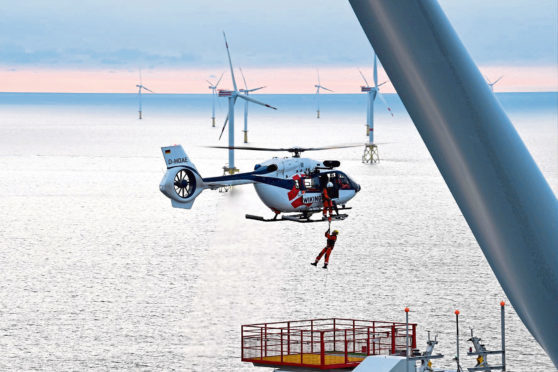Airbus Helicopters said yesterday it was targeting the global renewable energy market for new business.
The French aircraft manufacturer is looking to take advantage of new opportunities presented by the growing spread of offshore wind farms around the world.
It expects demand for up to 1,000 helicopters from the sector over the coming two decades, equating to revenue of about £8 billion.
For many people in the north-east, Airbus is synonymous with helicopters flying to and from oil and gas platforms in the North Sea.
Its Super Pumas were a familiar sight in the skies over Aberdeen, although they have not been used for flying workers offshore in the region since one of the aircraft crashed in Norway in April 2016.
As more wind turbines appear in the seas around Scotland, such as the European Offshore Wind Deployment Centre and Hywind Scotland projects off the north-east coast, Airbus may soon become a key player in this growing North Sea market.
The company is due to showcase its supply, maintenance and crew transport capabilities at the four-day WindEnergy expo in Hamburg, Germany, from today.
Dennis Bernitz, head of western Europe sales for the firm, said: “Helicopters are an integral part of any logistics concept for offshore wind farms.
“Our helicopters can complete missions for wind farms in a particularly quick, economical, safe and environmentally friendly manner.
“Helicopters can be used to deploy technicians or medical personnel in emergencies, even in rough seas, and can also transport operating personnel between the shore and the wind farm.”
According to Airbus, technicians travelling to and from wind farms by air are statistically less likely to make mistakes on the job.
The company said: “Helicopter transport means that personnel avoid problems with seasickness caused by travelling by sea in rough weather conditions.
“The probability of mistakes being made by seasick technicians is considerably higher than in the case of healthy technicians; in severe cases, the error rate climbs dramatically.
“With turbine output rising, leading to a higher rate of electricity production, wind farm operators rely on an efficient, rapid-response logistics system, relying on high availability, to keep losses to a minimum should a malfunction occur.
“At the same time, wind farms are being built further and further from the shore.
“A helicopter can cover 40 nautical miles (about 46 ‘land’ miles) in 20 minutes, meaning it can reach the site and return to shore faster than a transport vessel.”
Wind farm developers do not usually buy transport themselves, but lease the services from operators.
Helicopter operators traditionally associated with oil and gas work in the UK North Sea are also keen to diversify.
Last year, US-headquartered CHC Helicopter said new activities, including in the renewable energy sector, were a natural evolution for the business after the oil and gas downturn.
